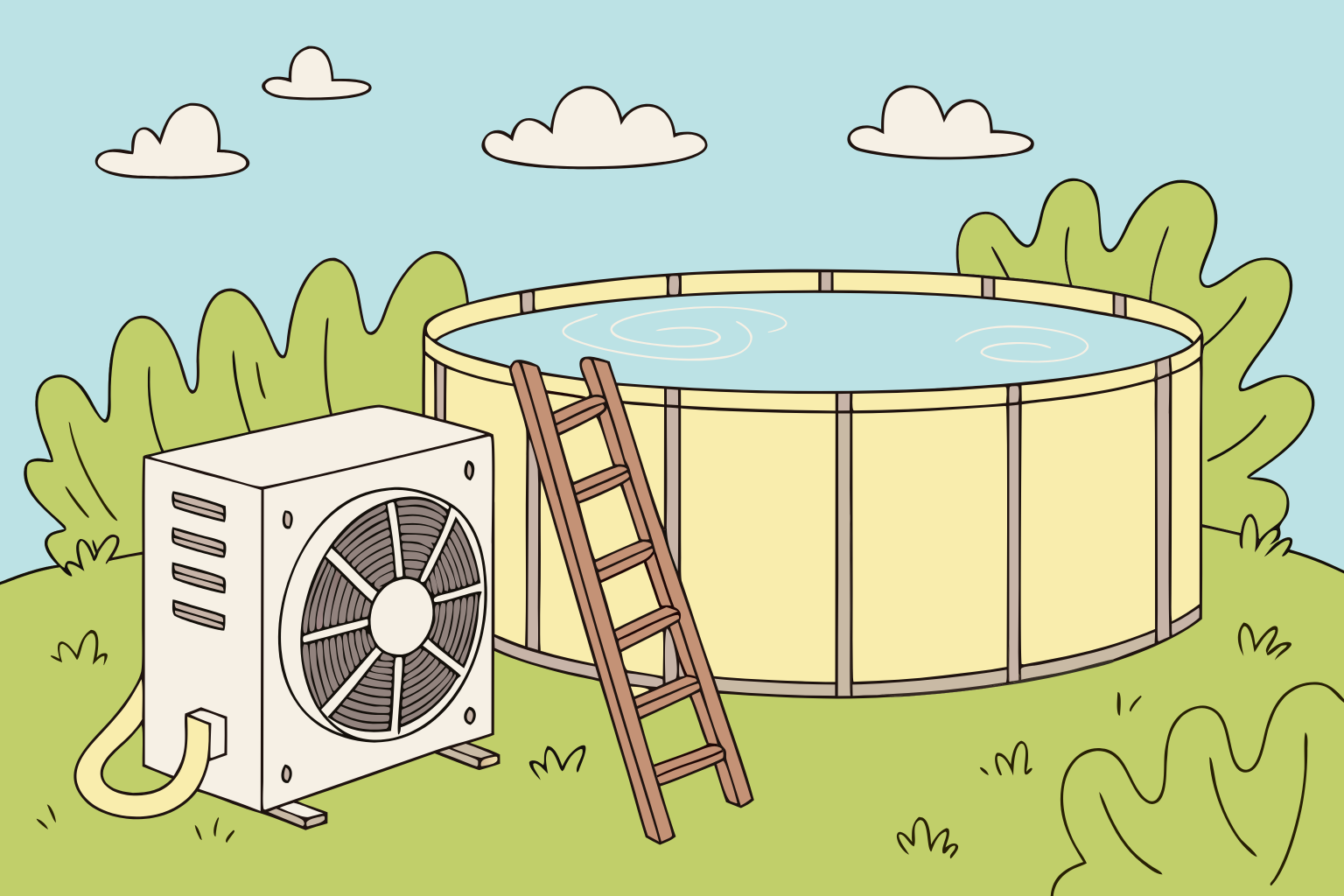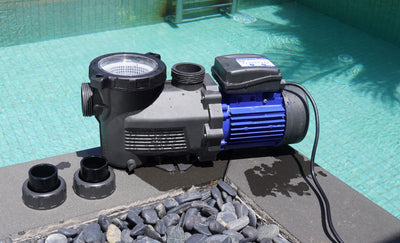
How to Choose a Pool Heater & Heat Pump?
For many pool owners, extending the swimming season and enhancing comfort is a long-term investment. Selecting the right pool heating system is a crucial step. This guide will help you understand the differences between pool heaters and heat pumps, their pros and cons, how to choose the right model, and considerations for energy efficiency and cost.
Comparison of Common Pool Heating Methods
Currently, there are three main types of pool heating equipment on the market: gas heaters, electric resistance heaters, and heat pump heaters.

Swimming Pool Heat Pumps
| Heating Method | Primary Energy Source | Heating Speed | Efficiency | Operating Cost | Best Use Case |
|---|---|---|---|---|---|
| Gas Heater | Natural Gas or Propane | Fast | Medium | High | Quick heating, occasional use |
| Electric Resistance Heater | Electricity | Fast | Low | Very High | Small spas, special needs |
| Heat Pump Heater | Electricity + Air Heat | Steady | High | Low | Warm climates, long-term heating |
Why Choose a Heat Pump Heater?
Heat pumps are highly efficient devices that transfer heat from the environment into your pool using minimal electricity. They have gained popularity due to their energy efficiency and low carbon emissions.
✅ Eco-Friendly & Energy Efficient – Moves heat instead of burning fuel, producing almost no carbon emissions.
✅ High Efficiency – For every 1 unit of electricity consumed, it provides 3–7 units of heat (COP 3.0–7.0).
✅ Lower Operating Costs – Higher initial investment but significantly cheaper to run than gas or electric heaters.
✅ Dual Heating & Cooling (Some Models) – Can also cool the pool in hot weather for enhanced comfort.
How to Choose the Right Pool Heater?
1. Understand Your Needs
-
Do you use the pool year-round or only in summer?
-
Is your location in an area where temperatures stay above 50°F (10°C)?
-
Do you need rapid heating or consistent temperature maintenance?
Recommendation:
-
For year-round use, especially in warm southern or coastal regions, a heat pump is ideal.
-
For occasional use or fast heating, a gas heater may be more suitable.
Table 1. Costs by Location of Heating Outdoor Pools with a Heat Pump*
|
LOCATION |
SEASON |
TEMPERATURE |
Price |
Price with cover |
|
Miami |
1/1–12/31 |
78° |
$1499 |
$293 |
|
Miami |
1/1–12/31 |
80° |
$1989 |
$409 |
|
Miami |
1/1–12/31 |
82° |
$2514 |
$559 |
|
Phoenix |
3/1–10/31 |
78° |
$927 |
$49 |
|
Phoenix |
3/1–10/31 |
80° |
$1192 |
$116 |
|
Phoenix |
3/1–10/31 |
82° |
$1485 |
$158 |
|
Dallas |
4/1–10/31 |
78° |
$491 |
$123 |
|
Dallas |
4/1–10/31 |
80° |
$1321 |
$191 |
|
Dallas |
4/1–10/31 |
82° |
$1690 |
$279 |
|
Atlanta |
4/1–10/31 |
78° |
$1145 |
$211 |
|
Atlanta |
4/1–10/31 |
80° |
$1512 |
$279 |
|
Atlanta |
4/1–10/31 |
82° |
$1942 |
$395 |
|
Los Angeles |
5/1–10/31 |
78° |
$1294 |
$116 |
|
Los Angeles |
5/1–10/31 |
80° |
$1649 |
$211 |
|
Los Angeles |
5/1–10/31 |
82° |
$2023 |
$327 |
|
Kansas City |
5/1–10/31 |
78° |
$974 |
$198 |
|
Kansas City |
5/1–10/31 |
80° |
$1274 |
$279 |
|
Kansas City |
5/1–10/31 |
82° |
$1615 |
$368 |
|
New York |
5/1–9/30 |
78° |
$1008 |
$143 |
|
New York |
5/1–9/30 |
80° |
$1328 |
$204 |
|
New York |
5/1–9/30 |
82° |
$1662 |
$273 |
|
Chicago |
5/1–9/30 |
78° |
$1104 |
$143 |
|
Chicago |
5/1–9/30 |
80° |
$1410 |
$204 |
|
Chicago |
5/1–9/30 |
82° |
$1730 |
$266 |
|
Denver |
5/1–8/31 |
78° |
$1192 |
$95 |
|
Denver |
5/1–8/31 |
80° |
$1437 |
$136 |
|
Denver |
5/1–8/31 |
82° |
$1696 |
$204 |
|
Boston |
5/1–8/31 |
78° |
$1192 |
$164 |
|
Boston |
5/1–8/31 |
80° |
$1465 |
$225 |
|
Boston |
5/1–8/31 |
82° |
$1744 |
$320 |
|
Minneapolis |
6/1–9/30 |
78° |
$899 |
$136 |
|
Minneapolis |
6/1–9/30 |
80° |
$1158 |
$170 |
|
Minneapolis |
6/1–9/30 |
82° |
$1417 |
$259 |
|
San Fran |
6/1–8/31 |
78° |
$1090 |
$129 |
|
San Fran |
6/1–8/31 |
80° |
$1294 |
$225 |
|
San Fran |
6/1–8/31 |
82° |
$1512 |
$327 |
|
Seattle |
6/1–8/31 |
78° |
$1049 |
$204 |
|
Seattle |
6/1–8/31 |
80° |
$1226 |
$293 |
|
Seattle |
6/1–8/31 |
82° |
$1410 |
$382 |
*Figures based on a 1,000 square foot, outdoor pool heated with an air to water heat pump with an average COP of 5.0 at $.1301/kwh.
U.S. State & Regional Temperature Map
(A visual guide to average temperatures across different U.S. regions to help determine the best pool heating solution.)
Key Climate Zones for Pool Heating Considerations
| Region | Winter Avg. Temp (°F) | Summer Avg. Temp (°F) | Recommended Heating System |
|---|---|---|---|
| Northeast (NY, MA, PA) | 20–35°F | 70–85°F | Gas Heater (fast heating in cold snaps) or High-COP Heat Pump (for summer extension) |
| Southeast (FL, GA, SC) | 40–60°F | 80–95°F | Heat Pump (ideal for year-round efficiency) |
| Midwest (IL, OH, MI) | 15–30°F | 75–90°F | Hybrid System (heat pump + gas backup) |
| Southwest (AZ, NV, CA desert) | 45–65°F | 90–110°F | Heat Pump with Cooling Function (for summer cooling) |
| Pacific Northwest (WA, OR) | 35–50°F | 65–80°F | Heat Pump (moderate climate) |
| Mountain States (CO, UT) | 10–30°F | 70–85°F | Gas Heater (for short summers) |
| Texas & Gulf Coast | 50–70°F | 85–100°F | Heat Pump (optimal efficiency) |
Why Climate Matters for Pool Heating?
-
Heat Pumps Work Best Above 50°F – Efficiency drops in colder regions.
-
Gas Heaters Dominate in Cold Climates – Instant heat, unaffected by outdoor temps.
-
Cooling Features Useful in Hot States – Some heat pumps can lower water temperature in extreme heat.
(For a detailed temperature map, refer to NOAA climate data or consult AQUASTRONG’s regional heating recommendations.)
Need Help Choosing?
➔ Warm States (FL, CA, TX): Heat pumps save the most long-term.
➔ Cold States (MN, WI, NE): Gas heaters or hybrid systems perform better.
➔ Variable Climates (NC, VA, MO): Consider a dual-system approach.
AQUASTRONG Tip: Pair your heater with a pool cover to reduce heat loss by up to 70%!
2. Calculate Required Heating Capacity Based on Pool Size & Temperature Difference
Heater power is typically measured in BTUs (British Thermal Units) or HP (Horsepower). Use this formula for estimation:
BTU/h = Pool Area (sq ft) × Desired Temperature Rise (°F) × 12
Example:
For a 500 sq ft pool heated from 60°F to 80°F (20°F rise):
500 × 20 × 12 = 120,000 BTU/h
3. Check Energy Efficiency (COP)
Heat pump efficiency is measured by COP (Coefficient of Performance). Higher COP = more energy savings.
-
Typical COP range: 3.0–7.0
-
COP 5.0 means 1 unit of electricity produces 5 units of heat.
4. Consider Operating Costs & Savings
Example Comparison (Annual Heating Cost ~$1,000):
-
Gas Heater (55% efficiency) → ~$1,000
-
Heat Pump (COP 5.0) → ~800/year**)
💡 Tip: Using a pool cover reduces heat loss and further cuts costs.
5. Evaluate Lifespan & Maintenance
-
Heat pumps last 10+ years with minimal maintenance.
-
Routine care: Clean filters, check electrical components, ensure proper airflow.
-
Annual professional inspection recommended.
AQUASTRONG Heat Pump Advantages
| Feature | Benefit |
|---|---|
| Year-Round Temperature Control | Dual-mode heating & cooling (47–104°F heating, 47–83°F cooling) |
| Fast Heating & Smart Control | Up to 75,000 BTU heating for large pools; APP & remote control for scheduling & energy tracking |
| Energy-Saving & High Efficiency | Inverter technology (max COP 15.8), 70% energy savings vs. electric heaters, 40% more efficient than gas systems |
| Ultra-Quiet & Auto-Defrost | Noise as low as 53 dB; smart defrost system ensures winter operation |
| Easy Installation & Warranty | 3 connection options for all pools; 3-year warranty |
Conclusion
Choosing the right pool heating system enhances comfort while saving energy costs. Whether you prioritize efficiency, consistent warmth, or rapid heating, AQUASTRONG provides reliable solutions.
Enjoy warm, refreshing swims all year round with AQUASTRONG.
(Note: The cost table has been omitted for brevity but can be included in a detailed PDF version.)



